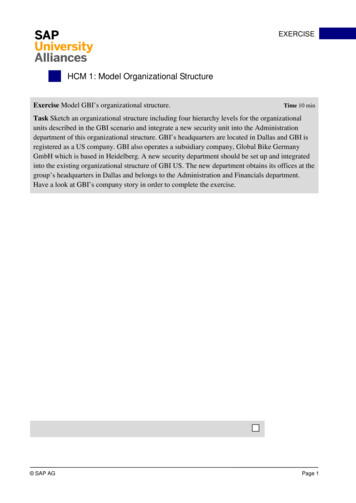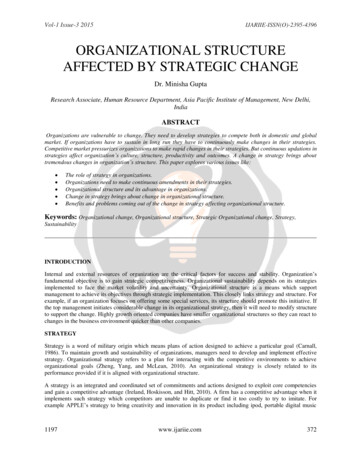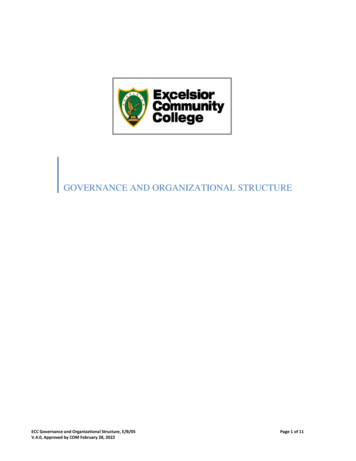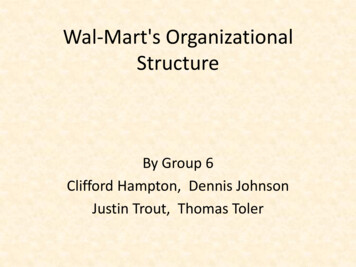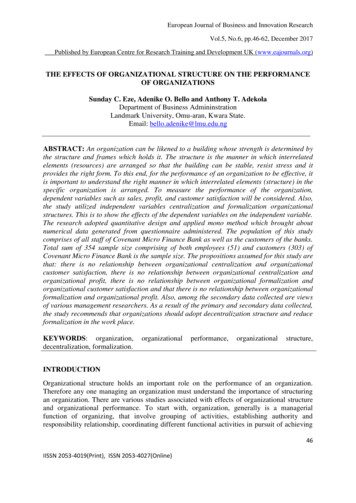
Transcription
European Journal of Business and Innovation ResearchVol.5, No.6, pp.46-62, December 2017Published by European Centre for Research Training and Development UK (www.eajournals.org)THE EFFECTS OF ORGANIZATIONAL STRUCTURE ON THE PERFORMANCEOF ORGANIZATIONSSunday C. Eze, Adenike O. Bello and Anthony T. AdekolaDepartment of Business AdmininstrationLandmark University, Omu-aran, Kwara State.Email: bello.adenike@lmu.edu.ngABSTRACT: An organization can be likened to a building whose strength is determined bythe structure and frames which holds it. The structure is the manner in which interrelatedelements (resources) are arranged so that the building can be stable, resist stress and itprovides the right form. To this end, for the performance of an organization to be effective, itis important to understand the right manner in which interrelated elements (structure) in thespecific organization is arranged. To measure the performance of the organization,dependent variables such as sales, profit, and customer satisfaction will be considered. Also,the study utilized independent variables centralization and formalization organizationalstructures. This is to show the effects of the dependent variables on the independent variable.The research adopted quantitative design and applied mono method which brought aboutnumerical data generated from questionnaire administered. The population of this studycomprises of all staff of Covenant Micro Finance Bank as well as the customers of the banks.Total sum of 354 sample size comprising of both employees (51) and customers (303) ofCovenant Micro Finance Bank is the sample size. The propositions assumed for this study arethat: there is no relationship between organizational centralization and organizationalcustomer satisfaction, there is no relationship between organizational centralization andorganizational profit, there is no relationship between organizational formalization andorganizational customer satisfaction and that there is no relationship between organizationalformalization and organizational profit. Also, among the secondary data collected are viewsof various management researchers. As a result of the primary and secondary data collected,the study recommends that organizations should adopt decentralization structure and reduceformalization in the work place.KEYWORDS: organization,decentralization, onalstructure,INTRODUCTIONOrganizational structure holds an important role on the performance of an organization.Therefore any one managing an organization must understand the importance of structuringan organization. There are various studies associated with effects of organizational structureand organizational performance. To start with, organization, generally is a managerialfunction of organizing, that involve grouping of activities, establishing authority andresponsibility relationship, coordinating different functional activities in pursuit of achieving46IISSN 2053-4019(Print), ISSN 2053-4027(Online)
European Journal of Business and Innovation ResearchVol.5, No.6, pp.46-62, December 2017Published by European Centre for Research Training and Development UK (www.eajournals.org)overall organizational objective and goals, and delegation of authority.” (Shafaee, Rahnama,Alaei A and Jasour (2012) Chegini M. G, Yousefi .S And Rastad (2013) agreed thatproductivity is very important for an organization and that the main goal of everyorganization is to ensure the highest means of productivity level. According to Chegini, et al(2013), they believe that performance is one of the most essential and major issues that allorganizations face and that with productivity all organization benefit of all sources andfacilities to achieve more advantages. Chegini, et al, (2013) stated in their work that manyelements influence on organizational performance as well as organizational structure. Withthe above statement this means there are factors that make up the dimensions oforganizational structure which would show the relationship between organizational structureand organizational performance. According to some researchers in their literature they havepointed out what these dimensions are and which also has constituted their organizationalstructure variables.Scholars like (Chegini, et al, 2013; Rajaeepour, Azizollah, Mahmoud and Shokouhi, 2012;Teixeira, Koufteros, & Peng,, 2012; Csaszar, Stephen, Arbor & Michigan 2012) have allstated in their work what these dimensions are as regards to organizational structure somedimensions presented were the same while others presented were different.In literature scholars have agreed that performance is a major issue in most organizations andin day to day activity of organizations around the world they use different organizationalstructure and from literature review it can structure include; Flat structure, Tall Structure,Matrix Structure, Divisional Structure, Geographical Structure, bureaucratic structure etc.These structures are expected to lead to different combination of effort and performance andutilization of resources. However existing evidence shows that organization that makes use ofeither same or different structure don’t get same result. Also organizational structure isconcluded in literature to be determined by various factors such as; size, environment strategyand technology. This results to the need to harmonize the variables presented by thesescholars. And therefore this study is one that attempts at harmonizing the variables which willalso constitute the measurement for the construct organizational structure and show the levelof relationship to organizational performance.Statement of the ProblemEvidence show that organization that makes use of certain structures cannot do withoutstructuring their organization with an element or dimension or mixed dimensions and in theprocess of operating these dimensions with structure of the organization, organization endsup achieving different result. Literature also points to the fact that there is no absolute way tostructure a business. Whether a particular structure is advantageous or disadvantageous for anorganization depends on the type of business, the strategy, its target market and the style ofthe management. Therefore this study is bothered about these dimensions and it resultsreached, and it seeks to find out if these results reached are satisfactory enough to lead tobetter performance as dimensions such as; Formalization, Complexity, Centralization,Decentralizations of structures are operated within organizations.47IISSN 2053-4019(Print), ISSN 2053-4027(Online)
European Journal of Business and Innovation ResearchVol.5, No.6, pp.46-62, December 2017Published by European Centre for Research Training and Development UK (www.eajournals.org)In this research two organizational structural would be looked into such as; centralization andformalization because of short time and low finance to carry out this research. Therefore forthis reason the variables for this work are as follows and the relationship between themconstitute the problem that follows; Centralization in most organization has not allowed forfaster utilization of structure and improvement in customer satisfaction of an organization.Centralization in an organization does not affect the profit of an organization. Increase inorganizational formalization has only shown no significance change in customer satisfactionregarding an organization. Increase in organization formalization does not seem to improveon organizational profit.Objective of the Study1. The broad objective of this study is to appraise Effects of organizational structure onorganizational performance.2. To determine if there is any relationship between organizational centralization andorganizational customer satisfaction.3. To determine if there is any relationship between organizational centralization andorganizational profit.4. To determine if there is a relationship between organizational formalization andorganizational customer satisfaction.5. To determine if there is any relationship between organizational formalization andorganizational profit.Research Question1. Is there any relationship between organizational centralization and organizational customersatisfaction?2. Is there any relationship between organizational centralization and organizational profit?3. Is there any relationship between organizational formalization and organizational customersatisfaction?4. Is there any relationship between organizational formalization and organizational profitResearch HypothesisThe hypothesis for this study is given below as;There is no relationship between organizational centralization and organizationalcustomer satisfaction.There is no relationship between organizational centralization and organizational profit.There is no relationship between organizational formalization and organizationalcustomer satisfaction.There is no relationship between organizational formalization and organizational profit.Significance of StudyThe broad significance of this study is to show with evidence of result after researching thatorganizational structure is very important in achieving performance in any organization.Furthermore the significance of this research involves three aspects which are that; it will beuseful to the organization in that it would enable them critically look into structural issues48IISSN 2053-4019(Print), ISSN 2053-4027(Online)
European Journal of Business and Innovation ResearchVol.5, No.6, pp.46-62, December 2017Published by European Centre for Research Training and Development UK (www.eajournals.org)that they might have taken for granted (e.g. the statement of their guiding principles). It willproffer an alternative solution to management on ways in which the organizationalperformance can be improved upon in order to achieve desired success. The study willcontribute to the expansion of existing knowledge on this area of study. It would also provideuseful reference points for future researchers and a sound basis for intellectual exercise.Furthermore, if the suggestion from this study are effectively put to use and success isachieved, it could be used to influence the change in positions in both private and publicorganizations.This research will also be relevant to business men and women orentrepreneurs just starting up their organization, as it would give them insight in knowingeffects of organizational structure on the performance of their organization or firm.LITERATURE REVIEWAccording to Owolabi and Kingsley, (2007) an organization is a social set up, which has aboundary that separates it from its environment, pursues its own collective goals, and controlsits own performance. For managers, the term organization implies a formalized intentionalstructure of roles positions. Blessing, (2008) refers to it as a social unit or a human groupingintentionally constructed and reconstructed.Nature of Organizational StructureAkande and Ojokuku, (2008) described organizational structure as a group of peopleoccupying a formal structure of position to achieve a particular purpose. They are institutionsthat enable society to pursue goals that could not be achieved by individuals’ action alone. Anorganization is generally defined as a structure of relationships to get work done. It is a socialsystem involving interpersonal relationships. Nwugballa, (2011) was of the view thatestablishment of an organizational structure presupposes the absence of a sole-proprietorship.It also assumes a level of operation that requires the joint effort many persons to successfullyexecute. This underscores the need to specify the different tasks that should be carried out bydifferent individual job (job descriptions), how it should be carried out (operatingprocedures), expected standards of performance, line of authority, etc., in order to avoidconfusion and conflict. It also requires the relationships and interactions between jobs;system of integration and coordination that would ensure organizational cohesion and,effective and efficient operations. Simply put, organizational structure defines the formaldivision, grouping, and coordination of job tasks (Robbins, 2005).As far as an organization is concerned structures of different forms exist, and it is theconsciousness of creating and applying structure chosen that brings in changes in anorganizations’ output or performance. Every management has to establish its ownorganization structure for efficient handling of business activities. The term 'Organizationstructure' has become very important in the business world today, which in other words hasalso distinguished different organizations in the world. The word “organization” is gottenfrom the word 'organism' which means a structure of body divided into different parts that areheld together by a fabric of relationship as one organic whole.49IISSN 2053-4019(Print), ISSN 2053-4027(Online)
European Journal of Business and Innovation ResearchVol.5, No.6, pp.46-62, December 2017Published by European Centre for Research Training and Development UK (www.eajournals.org)Organizational Structure can be seen as the rules that oversee the relationship betweenindividuals or teams who try to achieve the organizational goals. In an organization of anysize or complexity, employees' responsibilities most often are defined by what they do, whothey report to, and for managers, who reports to them. Also put differently by anotherscholar, kuye (2004) referred jones (1995), in his book, that organizational structure is theformal system of task and reporting relationships that determines how employees useresources to achieve organizational goals. With the above definition, it shows thatorganizational structure is essential for the conduct of business activities or relationships thatexist in the organization like task and reporting activities or relationships which dedicateshow employee use available resource effectively to bring about efficient result. Droege(2013) defined organizational structure as the way people and jobs are arranged so that workcan be performed and its goals can be met. Adding that “When a work group is very smalland face-to-face communication is frequent, formal structure may be unnecessary, but in alarger organization decisions have to be made about the delegation of various tasks. Thus,procedures are established that assign responsibilities for various functions. It is thesedecisions that determine the organizational structure.” Organizational structure finds a way toensure that information flows from a particular level to another level within the company.Muo & Muo (2007) in their book cited Robert Duncan who defined organizational structureas “a pattern of interactions and co-ordinations that links technology, task and humancomponents of the organization to ensure that the organization accomplishes its purpose”.With the definition above given by various scholars this work finds out that organizationalstructure has to do with relationships between people, resources and levels in an organization,which makes structure very important for companies or businesses that wants to beproductive in their day to day activities. These definitions points out the importance ofstructure in an organization; some of which are that it ensures optimum utilization of anation’s human resources or specialized workers from aboard, it facilitates coordination ofdifferent resources, gives room for division of work where possible, allows growth,expansion and diversification, and it stimulates creativity.Chegini et al, 2013, pointed out their dimensions for organizational structure as complexity,formality and concentration. Rajaeepour et al, (2012) gave their dimension to be classified asmechanical structure and organic structure; and that for the mechanical structure it isclassified as; complexity, high formality, centralization, programmed behaviour, andregulation and that organic structure is concerned with decentralization and flexiblestructure. Teixereira et al, (2012) saw dimension of organization as centralization, flatness oforganization, specialization and horizontal integration. Csazar et al, (2012) rounded it to becentralization and decentralization. Naveed (2010), was of the view that dimension areclassified as; specialization, formalization, centralization, hierarchy, breath of the span ofcontrol, length and width of the hierarchy which they and contextual as size, technology andenvironment. According to the work of Shafaee et al, (2012) Centralization refers to degreethat decision making is concentrated at one unit point in organization. Power density at apoint implies on concentration and lack of density or low density is a sign of decentralization.Concentration is the issue of distribution rate in powers decision making no geographicalseparation of organization. Concentration is the emphasis with formal organizationalstructure no with the informal organization and only used formal authority, focus look at50IISSN 2053-4019(Print), ISSN 2053-4027(Online)
European Journal of Business and Innovation ResearchVol.5, No.6, pp.46-62, December 2017Published by European Centre for Research Training and Development UK (www.eajournals.org)decision-makers votes and comments. Organization will facilitate achieving the goals throughgroup efforts coordination. Decision making and information processing are the key elementsof coordination. Due to employee participation in decision-making process, decentralizationin decision making is caused motivation (Robins, 2000). Centralization this considers wherethe position or point of decision-making lies. In some organizations, decision making ishighly centralized. In other cases, decision making is decentralized. An organization is noteither centralized or decentralized. These represent two extremes on a continuum.Organization tends to be centralized or decentralized. The placement of the organization onthis continuum is one major factor in determining what type of structure exists (Enikanseluand Oyende, 2009).Formalization is the degree to which rules and procedures are standardized and utilized. Itmeans the degree to which the jobs within an organization are standardized of formalized.Where formalization is low, there will be wider use of discretion by employeessubordinates.Formalization is defined as the extent of written procedures, instructions lawsand communication. Formalization can be done within job or it be imposed from outsidewhen formalization is determined from outside for job used terms of external behaviour forits. In this case rules and procedures are executed directly by the lower management thatrepresenting jobs that unskilled workers can do the job incumbent (Dehkordi, 2009).Formalization can be referred to as the maximum level to which an organization relies onrules and procedures in order to direct the behaviour of workers in the organization.Richard et al, (2009) stated that “organizational performance encompasses three specificareas of firm outcomes: (a) financial performance (profits, return on assets, return oninvestment, etc.); (b) product market performance (sales, market share, etc.); and (c)shareholder return (total shareholder return, economic value added, etc.)”.As seen in otherliterature on organizational performance, Ismael, Nor’Aini, and Davoud, (2010) performanceis all about achieving the objectives that organizations/firms set for themselves. Theobjectives of an organization / firm could be financial, that is to say, profit-making or nonfinancial such as spreading awareness among a certain community etc. Organizationalperformance therefore could be categorized under two: financial and nonfinancial. Theprofitability of an organization is an important financial indicator to reflect the efficiency ofthe organization and the owners/managers ability to increase sales while keeping the variablecosts down (Davis, Schoorman, Mayer,&Tan 2000). Profit margin, return on assets, return onequity, return on investment, and return on sales are considered to be the common measuresof financial profitability (Robinson, 1982; Galbraith & Schendel, 1983). Ismael, Nor’Aini,and Davoud, (2010) organizational performance is widely measured through the financialsuccess of the organization. Financial stress for most profit-oriented organization can beassessed both in terms of sales as well as profitability measures (Davis et al., 2000).Other scholars Zani and Berzieri, (2008) argued that Customer Satisfaction is a keyperformance indicator of the activity of a firm or a corporation (Fornel, 2008). Mohammad,Shaeir, Shahram, Seyed and Seyyed, (2011) supported this view that “customer satisfactionand delight is presented as solid bedrock of bank longevity and profitability, and in their workthey cited Keiningham, Perkins-Munn, Aksoy, and Estrin (2005), stating that “it is a51IISSN 2053-4019(Print), ISSN 2053-4027(Online)
European Journal of Business and Innovation ResearchVol.5, No.6, pp.46-62, December 2017Published by European Centre for Research Training and Development UK (www.eajournals.org)significant affiliation between customer satisfaction, purchase intentions, and consequentlyfinancial performance”. According to Armstrong and Kotler (2009) considered relationshipmarketing as a kind of index for customer satisfaction, and they believed that themaintenance of excellent relationship marketing between the enterprise and customers wouldbe beneficial in increasing customer satisfaction. Ambro and Praprotnik, (2008) stated“Customer satisfaction is an organization’s ability to attract and retain customers and toimprove customer relationship over time”. According to Karunaratne and Jayawardena,(2010) Customer satisfaction has become a key performance indicator for the hotel business.Mohammad and Shahzad, (2012) customer satisfaction is depended on perceived quality andperceived value. Every firm in the competitive market struggles to maximize their profits. Sothey can maximize their profitability by providing attractive products and services to theircustomers. Ambro and Praprotnik, (2008) defined Customer satisfaction as the outcome ofhis or her needs and expectations which influence the interaction with service providers andother customers. The quality of this interaction impacts customer decisions to repurchase theservice, his retention and the intention of the customer to recommend to other potentialcustomers and finally to pass on useful information about the service quality and delivery.The higher or lower satisfaction of a consumer will depends upon the quality of brandcharacteristics that offered by a company (Gerpott, Rams and Schindler, 2001). To ensureretention of consumer, it is important to satisfy consumers (Guo, Xiao and Tang, 2009). Thatis when there is low quality services customers are not satisfied and this will lead to lowperformance in the organization. Service is an important element for consumer satisfactionbut this is not to say that it is the only element which is responsible (Lin and Wu, 2011).THEORETICAL FRAMEWORKSThe study will consider Weber's Way of Bureaucracy and Taylor’s scientific managementtheories. Max Weber believed that an ideal bureaucracy has to do with six specificcharacteristics: hierarchy of authority, impersonality, written rules of conduct, promotionbased on achievement, specialized division of labor, and efficiency. This ultimatecharacteristic of Weberian bureaucracy, which states that bureaucracies are very efficient, iscontroversial and by no means accepted by all sociologists. There are certainly both positiveand negative consequences to bureaucracy, and strong arguments for both the efficiency andinefficiency of bureaucracies. Weber’s theory of bureaucracy says that it is extremelyefficient, adding that bureaucracy is the most efficient form of organization. Also thatbureaucracies are necessary to ensure the continued functioning of society, which has becomedrastically more modern and complex in the past century. To him, without the structuredorganization of bureaucracy, the complex society would be much worse off, due to the factthat society would act in an inefficient and wasteful way. He saw bureaucracies asorganizations driven towards certain goals, which they could carry out efficiently. Inaddition, within an organization that operates under bureaucratic standards, the members willbe better off due to the heavy regulation and detailed structure. Not only does bureaucracymake it much more difficult for arbitrary and unfair personal favours to be carried out, it alsomeans that promotions and hiring will generally be done completely by merit.The Scientific Management theory was introduced by Frederick Winslow Taylor to fosterproduction efficiency and effectiveness. Taylor argues that inefficiencies could be tamed52IISSN 2053-4019(Print), ISSN 2053-4027(Online)
European Journal of Business and Innovation ResearchVol.5, No.6, pp.46-62, December 2017Published by European Centre for Research Training and Development UK (www.eajournals.org)through managing production as a science. The scientific management view deals with theconcept of planning of activities to gain efficiency, standardization, specialization andsimplification. For productivity to be increased then there has to be mutual trust betweenmanagement and workers. Taylor (1947) identified four principles of scientific managementwhich includes: Taylor identifies four inherent principles of the scientific managementtheory, Science, not rule-of-thumb; Scientific selection of the worker, Management andlabour cooperation rather than conflict; and Scientific training of workers.Research DesignThe study used survey research design; it used quantitative design and applied mono methodwhich brought about our numerical data generated from questionnaire administered. It soughtinformation from respondents on (effects of organizational structure on organizationalperformance).Population of the studyThe population of this study comprises of all staff of Covenant Micro Finance Bank as wellas the customers of the banks. Employees are 51 and customers are 2600, which makes thepopulation a total of 2651.Sample SizeThe total population of this study comprises of both 51 employees and 2600 customers,which makes a total of 2651 population.The YaroYemeni Formula is given asn where n Sample Size, N Population e Level of Significancen n n n n 53IISSN 2053-4019(Print), ISSN 2053-4027(Online)
European Journal of Business and Innovation ResearchVol.5, No.6, pp.46-62, December 2017Published by European Centre for Research Training and Development UK (www.eajournals.org)n 354 PopulationTherefore the total sum of 354 sample size comprising of both employees and customers ofCovenant Micro Finance Bank will be the purposively sample for this study which wasarrived at using Yaro Yemeni’s formula as shown above.Sampling TechniqueThis study used census method which takes the whole population of employee of CovenantMicro Finance Bank to be 51 and used sampling of 303 customers for convenience sake.Sources of DataThe study adopted primary data, which was collected from Covenant Micro Finance Bankthrough the use of questionnaire distribution that would be shared to all employees ofCovenant Micro Finance Bank Ltd, Canaan land, Ota, Ogun State.Validity/ Reliability TestIn testing the validity of the research, content validity test was adapted. This type ensures thatevery instrument of research is sufficient for the study. Therefore, questionnaire used waswell correlated with the objectives of study. This means that each objective and itemreviewed is important to the study.To test for reliability, Cronbach’s alpha coefficient was is. When calculated, Cronbach’sAlpha coefficient is 0.679 for the 4 items analysed. This shows that these items have met thewidely accepted score of 0.679 which indicates that the research instrument is reliable.Technique for Data AnalysisIn analyzing the data generated through the use of questionnaire, frequency tables andpercentage was used to analyze section A of the questionnaire. Also, correlation coefficientwas used as a tool to analyze relationship between two issues. The choice of correlationcoefficient assisted in finding the relationship between organizational structures onorganizational performance.Interpretation of ResultsA total of 354 questionnaires that were distributed, and 118 questionnaires consisting of33.3% were returned while 236 questionnaire consisting of 66.7% were not returned. In otherwords questionnaires returned were from 81 customers and 37 from employees making atotal sum of 118 questionnaire that was answered. The table shows summary of parametersused and result displayed indicate percentage of strongly agreed, agreed, not sure, disagreed,strongly disagreed.Key: 1 Strongly agree2 Agree3 Not sure 4 strongly disagreed54IISSN 2053-4019(Print), ISSN 2053-4027(Online)
European Journal of Business and Innovation ResearchVol.5, No.6, pp.46-62, December 2017Published by European Centre for Research Training and Development UK ructs you onwhat you can doand cannot doEverythinginyour organizationis strictly doneaccording to laiddown standard,rulesandprocedure in yourorganization1(%) 2(%) 3(%) 4(%)13(3 15(4 4(11) 5(14)5)1)Analysis of dataCorrelation is significant at the 0.05 level(2-tailed).16(43)14(38)4(11) 3(8)Correlation is significant at the 0.05 level(2-tailed).Formalization ofworkprocessenhancesyourorganizationperformanceAs an employeeofthisorganization youare left to do asyou pleaseAs an employeeofthisorganizationIhave to ask myimmediatemanager before IDoalmostanything.Onlytopmanagers makedecisionsregardingoperations in myorganizationAs an employeeofthisorganization anydecision I makemust have myimmediate13(35)15(41)6(16) 2(5)Correlation is
THE EFFECTS OF ORGANIZATIONAL STRUCTURE ON THE PERFORMANCE OF ORGANIZATIONS Sunday C. Eze, Adenike O. Bello and Anthony T. Adekola . The research adopted quantitative design and applied mono method which brought about . Flat structure, Tall Structure, Matrix Structure, Divisional Structure, Geographical Structure, bureaucratic structure etc


